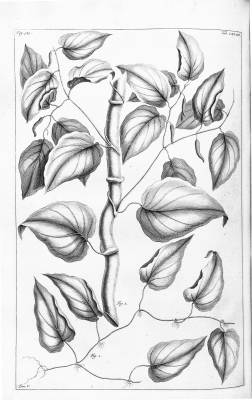Piper caducibracteum
C.DC.
Piperaceae
Common Name: Amelaun
General Information
Piper caducibracteum is an evergreen climbing shrub, producing perennial stems that scramble over the ground or twine into the surrounding vegetation[
310- Title
- Plant Resources of Southeast Asia
- Publication
-
- Author
-
- Website
- http://proseanet.org/
- Publisher
-
- Year
- 0
- ISBN
-
- Description
- Lots of information on the uses of the plants of SE Asia.
].
The plant is sometimes gathered from the wild and used as a substitute for Piper betle in a masticatory with betel nut[
310- Title
- Plant Resources of Southeast Asia
- Publication
-
- Author
-
- Website
- http://proseanet.org/
- Publisher
-
- Year
- 0
- ISBN
-
- Description
- Lots of information on the uses of the plants of SE Asia.
].
Known Hazards
None known
Botanical References
Range
Southeast Asia - Indonesia in the Moluccas.
Habitat
Locally common in woodland, where it straggles over other plants[
310- Title
- Plant Resources of Southeast Asia
- Publication
-
- Author
-
- Website
- http://proseanet.org/
- Publisher
-
- Year
- 0
- ISBN
-
- Description
- Lots of information on the uses of the plants of SE Asia.
].
Properties
| Edibility Rating |      |
| Habit | Evergreen Climber |
| Height | 0.00 m |
| Cultivation Status | Wild |
Cultivation Details
Scrambling plants form new roots where their leaf axils touch the ground[
K- Title
- Plants for a Future
- Author
- Ken Fern
- Description
- Notes from observations, tasting etc at Plants For A Future and on field trips.
].
A dioecious species - both male and female forms need to be grown if fruit and seed are required.
Edible Uses
The fresh or dried bark, the petioles and the young leaves can be used as a substitute for the leaf of Piper betle in a masticatory with betel nut (Areca spp.)[
310- Title
- Plant Resources of Southeast Asia
- Publication
-
- Author
-
- Website
- http://proseanet.org/
- Publisher
-
- Year
- 0
- ISBN
-
- Description
- Lots of information on the uses of the plants of SE Asia.
]. The leaves of this species are preferred by some people[
46- Title
- Dictionary of Economic Plants.
- Publication
-
- Author
- Uphof. J. C. Th.
- Publisher
- Weinheim
- Year
- 1959
- ISBN
- -
- Description
- An excellent and very comprehensive guide but it only gives very short descriptions of the uses without any details of how to utilize the plants. Not for the casual reader.
]. This use is detailed below:-
A mixture of betel leaves and other ingredients is used as a masticatory, which acts as a gentle stimulant and is taken after meals to sweeten the breath. The ingredients of the betel mixture (quid) can vary widely per country or region. The three basic ingredients are often the betel leaf, the seed ('nut') from the areca palm (Areca catechu L.) and lime, produced by burning seashells or slabs of limestone. In the Moluccas and certain regions of Papua New Guinea, the betel leaf is replaced by the inflorescence of Piper siriboa. Other possible ingredients include gambier (Uncaria gambir), tobacco, palm sugar and various spices, such as cardamom (Elettaria cardamomum) and clove (Syzygium aromaticum). The various mixtures provide a wide range of different tastes. Chewing the quid discolours teeth and stains saliva, mouth and lips red. It results in copious salivation, so users have to spit frequently[
310- Title
- Plant Resources of Southeast Asia
- Publication
-
- Author
-
- Website
- http://proseanet.org/
- Publisher
-
- Year
- 0
- ISBN
-
- Description
- Lots of information on the uses of the plants of SE Asia.
].
Chewing betel quids can lead to cancers in the mouth and on the tongue[
254- Title
- The Encyclopedia of Medicinal Plants
- Publication
-
- Author
- Chevallier. A.
- Publisher
- Dorling Kindersley. London
- Year
- 1996
- ISBN
- 9-780751-303148
- Description
- An excellent guide to over 500 of the more well known medicinal herbs from around the world.
].
Medicinal
None known
Other Uses
None known
Propagation
Seed -
Cuttings 30 - 45cm long, taken from the tips of vertical shoots[
310- Title
- Plant Resources of Southeast Asia
- Publication
-
- Author
-
- Website
- http://proseanet.org/
- Publisher
-
- Year
- 0
- ISBN
-
- Description
- Lots of information on the uses of the plants of SE Asia.
]. Cuttings usually have 3 - 5 nodes and are planted with the lowest 2 nodes buried in the soil. The cuttings are planted in nurseries or, more commonly, directly in the field, where they are planted close together in pits or long mounds. When the cuttings begin to sprout and creep along, they are tied to the support[
310- Title
- Plant Resources of Southeast Asia
- Publication
-
- Author
-
- Website
- http://proseanet.org/
- Publisher
-
- Year
- 0
- ISBN
-
- Description
- Lots of information on the uses of the plants of SE Asia.
]
If you have any useful information about this plant, please leave a comment. Comments have to be approved before they are shown here.


 Useful Tropical Plants Database 2014 by
Ken Fern,
web interface by
Ajna Fern
with help from
Richard Morris.
Useful Tropical Plants Database 2014 by
Ken Fern,
web interface by
Ajna Fern
with help from
Richard Morris.